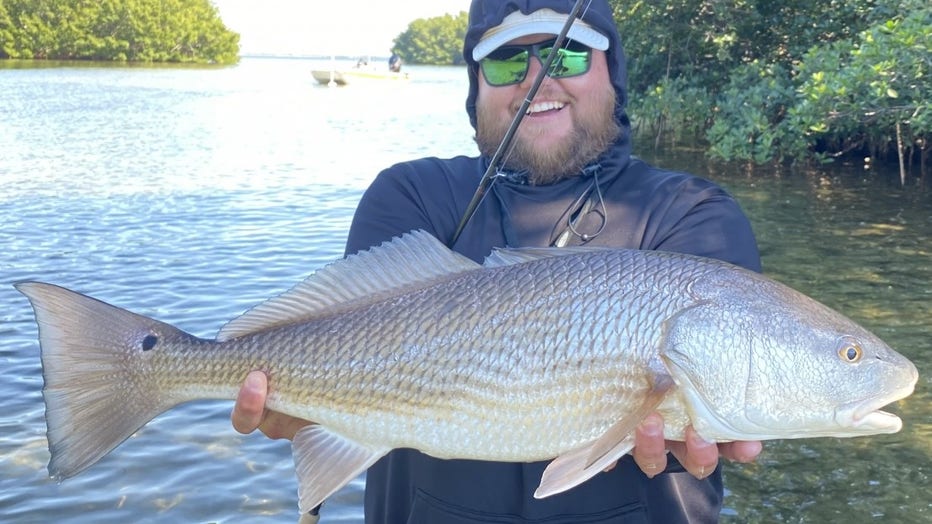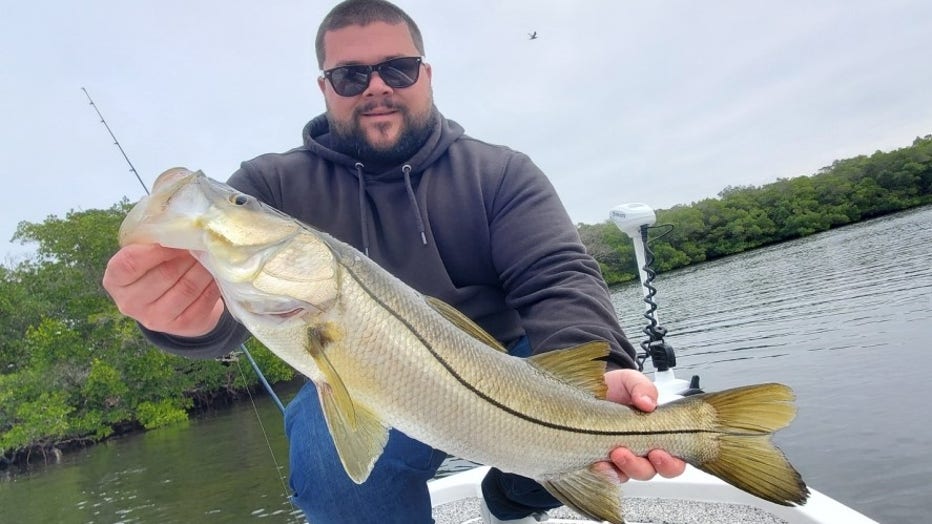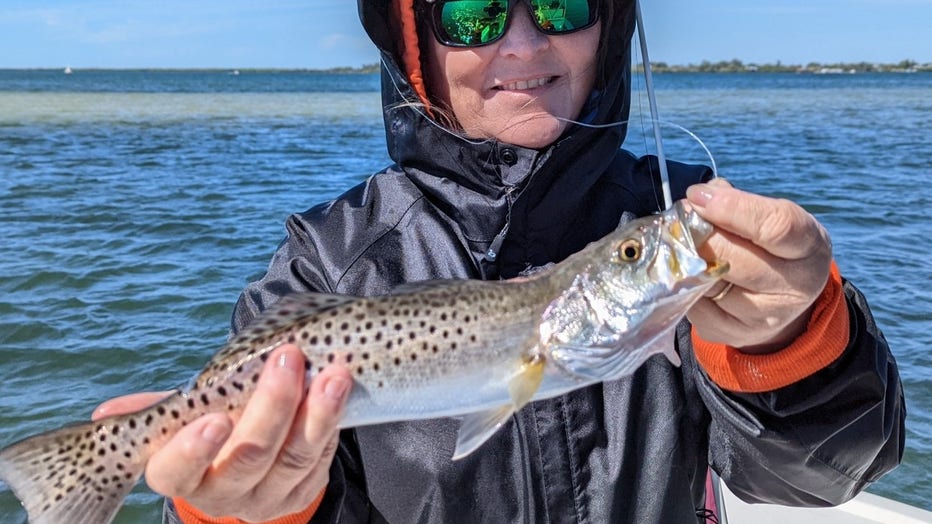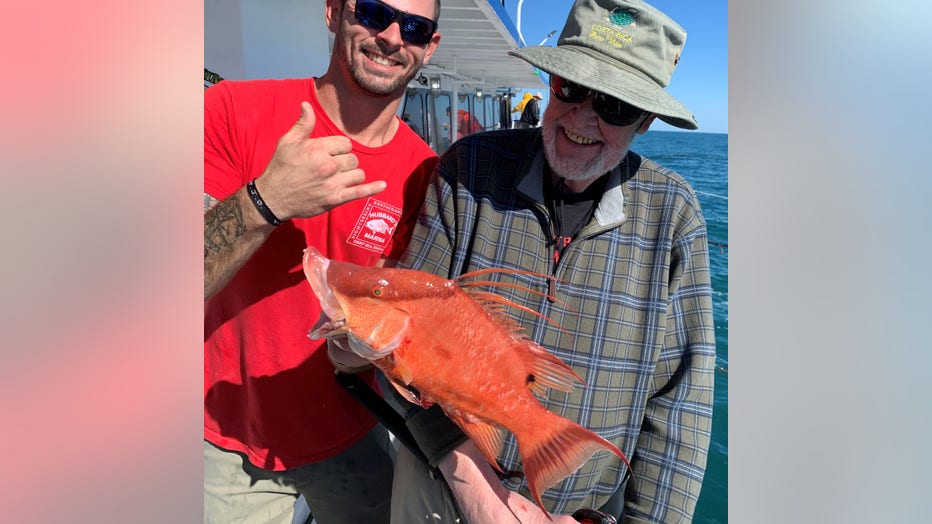Fishing Report: Feb. 4, 2022

Redfish, sheepshead biting inshore during roller-coaster weather in Bay Area
The best time to get out there would be between fronts, such as Friday or right behind the front?s weather on Sunday to take advantage of the moving barometer and stronger tidal flows before things get settled in for the week, says Captain Dylan Hubbard of Hubbard?s Marina. Sheepshead and redfish were biting this past week.
MADEIRA BEACH, Fla. - Every Friday morning, Captain Dylan Hubbard of Hubbard's Marina joins Good Day to fill viewers in on his fishing forecast as we head into the weekend.
Here is his fishing report for Feb. 4, 2022.
Weather effects of fishing
We are coming up on the first quarter moon on the backside of the new moon, so tides will be weakening a bit this week.
Plus, we have a big front coming through Saturday that will be stalling just south of our area. Due to this, we will have nearly a seven-day period of north winds, which will stagnate our barometer low and temperatures will get lower as well. Between a static low barometer, static wind patterns, cooler temperatures, and weaker tides, fishing will be tougher through the work week especially inshore.
LINK: FOX 13 weather forecast
The best time to get out there would be Friday or right behind the front’s weather on Sunday to take advantage of the moving barometer and stronger tidal flows before things get settled in for the week.
Inshore
We are seeing a good bite of redfish this past week around the area, especially in the later afternoons. The areas holding fish will be the ones with the warmer water temperatures where they can more actively feed.

Redfish (Credit: Hubbard's Marina)
Look for those mangrove shorelines, sea walls, mud banks, or oyster bars baking in the afternoon sun for the best opportunities for more actively-feeding fish. We did see some redfish action around the dock lines of the passes too, but most often on those tides where that warmer water was pushing through the area. Live shrimp is becoming more and more of a great option for the redfish, but super slow-moving soft plastics or cut dead bait is also working well too.
Snook were tough to find actively feeding this past week compared to the redfish as they are more susceptible to the cold slowing them down and shutting down their bite.
However, some nice fish were caught in the back bay area where the water is shallower and will warm up much more quickly. We found them around those mangrove shorelines and oyster bars and up with that darker bay mud that will radiate plenty of heat in the later afternoon after the sun has a chance to warm it up some. Look for those little cuts, pockets, and points around the mangroves and cast up into the mangroves working your bait away from it.

Snook (Credit: Hubbard's Marina)
Trout action has been spotty around the area, but when you are able to find them, they have been biting well for people working those soft plastics, live shrimp, or white baits. They are definitely sticking a bit shallower and hanging on the edges, cuts, and potholes of the flats of the back bay areas. We are also seeing some decent numbers of trout on the underwater lights of the area too.

Trout (Credit: Hubbard's Marina)
Sheepshead fishing is going well around the bay and along the coast where you can find some structures to fish with minimal weights and lighter tackle. They are picky and are looking for those smaller pieces of shrimp, cut oysters, clams or fiddler crabs. Try and use minimal weight just enough to get your bait to the structures. Even in that dirty stirred-up water condition behind a front, the sheepshead seem to flourish and still be plenty active and hungry.
Black drum are still around the area too, hunting around bridges, dock lines, oyster bars, and occasionally even the flats too. Look for them with the live shrimp or cut crabs weighted to the bottom -- especially local bridges that are near grass flats or bayou areas.
Flounder are around the area biting fairly well if you can hone into the areas they are hanging -- especially those sandy patches around the flats, around local docks, piers, or bridges too. They are always going to feed right on or near the bottom, and they are looking for the live shrimp, mud minnows, small pinfish or slower-moving soft plastics bounced along the bottom.
Near shore
The hogfish bite has been really good this past week, especially at the start of the week. We saw an incredible hogfish bite around 40-50 feet of water on our half-day fishing trip. Plus, the all-day trips have been doing really well on hogfish too around 50-80 feet of water.
Look for them on the lighter tackle around 20-30lb leaders and 3-4ot hooks and around 1-2oz weights on spinning rods. Look for the hogfish around smaller ledges, rock piles or hard bottom areas. They are really prolific around those shell bottom areas, adjacent to the hard areas as well. Often, where you find one, there will be more in the surrounding areas and structures too.

Hogfish (Credit: Hubbard's Marina)
Lane snapper action has been very good around 70-100 feet of water too. We can find them shallower too, but they are most concentrated past 70 feet of water. They love some live shrimp like the hogfish, but we can get them on small pieces of squid and small chunks of threadfins as well. Smaller hooks work best like the hogfish I wouldn’t suggest more than 4ot for targeting the lane snappers near shore.
Mangrove snapper action has been pretty decent near shore as well. We are even seeing some fairly large mangrove snapper closer to 100 feet of water. You can find them shallow too, but the deeper you get near shore, the more likely you will find bigger concentrations of mangrove snappers.
The cut threadfins, sardines, or cigar minnows on the double snell rig with 30-40lb leaders and around 4ot hooks are a great idea when targeting mangrove snapper in the deeper near shore waters. These guys are super smart and leader-shy fish, but lately, the more stirred up water conditions have allowed us to have a great opportunity at catching them even during the day when typically, they are a more nocturnal feeder.
Overcast conditions also help the daytime mangrove snapper bite too. Combining overcast conditions with the more murky waters is a great recipe for a better opportunity to do well on mangrove snappers during the day.
Red grouper action near shore has been spotty at best and definitely gets better as you move deeper. Getting closer to around 100 feet of water is going to give you the best chance at finding larger and more numerous red grouper. They are loving the whole threadfins with the tails cut or live pinfish for the most part, but we do often get them on butterflied grey snapper or grunts or squirrelfish as well. Using around 6-7ot hooks depending on your bait size is a good option for the red grouper.
Offshore
Yet again, it was a bumpier week of weather making it trickier to get offshore to the deeper waters to target the big offshore red grouper, scamp, and mangroves.
However, we were able to get out there Monday and did extremely well on all three of these species. This was a special trip where we left our bait at home and didn’t take anything with us besides some metal jigs and specialty rods for a unique public slow pitch jigging trip aboard our Flying HUB 2!
We have done a few private charters for this style of fishing, but never have we offered a public party boat style trip where guests could book individual spots for SPJ (slow pitch jig) fishing. As it turned out, we did really well while using this unique tactic and technique to jig up some grouper and snapper.
I am by no means an expert at this style of fishing, so this trip was a great learning experience for me, and I was blessed to be fishing with some real experts in the game of slow-pitch fishing. I learned quickly how to set up the jigs, work the jigs, and fight the fish on these extremely light rods and reels. I was using our Temple Reef Levitate Nabla rods from the shop paired with the Daiwa Saltiga 35JH reel. Then I used our JYG, Johnny’s Jigs, and some NLO jigs.
One big thing I had to learn was how to work the jigs without getting the light-braided line wrapped around the tip of the rod. These specialty rods are all about the ‘recoil’ that will cause the jig to produce the action you’re looking for. However, what I didn’t know is that same recoil will often cause the line to wrap around the tip of the rod and if that happens and you hook up, "snap" goes that super light rod tip in an instant.
Due to this, I spent most of the morning trying to account for wind and use that to keep the braid from the tip. However, after much trial and error, I was finally told the secret of ‘following the line’ you don’t need to jerk way up and then instantly lower the rod tip.
You can lower the rod after working it up much more slowly just fast enough to keep the line slack. This is called ‘following the line’ and allows the jig to work but prevents excess line from entangling your rod tip. This takes extreme concentration on every movement of the rod tip and line. It was a much more involved style of fishing which was super entrancing and definitely locks your attention.
Another big mistake I made at the start was ‘overworking’ the rod, I was raising it up 60-80 degrees trying to get the jig a lot of motion. Wat I learned quickly from watching the more experienced anglers on the boat was that you only need to work the rod sometimes as little as 15-30 degrees up to get the motion on the jig and keep it closer to ‘bouncing the bottom’.
If you’re trying to target grouper, snapper, and other bottom species pulling way up on the rod will sometimes prevent them from having a shot at hitting the jig unless they are super aggressive. While smaller movements keep the jig interacting with or staying right near the bottom.
Occasionally, I would reel a quarter crank or half crank while the jig fell to move the jig off the bottom some, but after doing this 10 times or so I would drop it back down until it hit bottom and stay on the bottom awhile before working slowly off the bottom.
This seemed to give me great results at not only the more bottom-orientated grouper and mangroves, but also the vermilion, almacos, and of course, the pesky red snapper I was trying to avoid.
I also learned about how you can vary your approaches but doing some smaller movements, some larger movements, and sprinkling in a mixture until you find what works.
Another big learning moment for me was learning to adjust the jigs and when to adjust the jigs. The common rule of thumb is one gram for every foot of water, but if the current is lighter or drift is slower you can go way lower. For example, we were fishing around 200 feet so, being a novice, I went right to a 200gram jig but noticed the guys catching fish were using much lighter 100-150gram jigs since our drift was so slow.
Then, colors -- that was cool to learn as well. Early morning, with lower light conditions, the glow-striped, darker-colored jigs seemed to work well. While later in the day, once it became brighter, we saw the more shimmering or reflective jigs without glow working better with brighter colored jigs too.
However, we were all working together shouting out what jig, what action and what weight and color it was when a really nice fish came up. Sharing intel allowed the boat to hone into what was working in each area and depth as a team.
Finally, something I have always thought to be true held true here too, the more natural color patterns or the wild ones that mimic a more natural pattern seemed to be most productive. That’s why a lot of guys really liked those NLO jigs that literally are made to look like the natural baits out there.
Many of the most experienced jig fisherman liked those glow-striped darker jigs in the morning, brighter more solid jigs during mid-morning and then very realistic or reflective jigs during the day it seemed.
Also, when it comes to hook sizes, you need a variety to match up with your jig. Some were using as small as 2-3ot assist hooks for the smaller fatter jigs while the same weight jigs that were longer and taller were rigged with 4-5ot hooks.
The main goal was keeping your hooks from getting near each other since most are rigging assist hooks at the top and bottom of the jigs when fishing less than 300-400 feet of water. Once you get super deep, they start going to assist hooks only on one side or the single assist hooks. That was yet another big learning curve.
Needless to say, I got a big jolt of slow pitch knowledge in a very short time, and I look forward to planning more of these trips in the near future!
Don't be a fool; bring a venting tool and/or a descending device
It is so important to keep in mind the importance of dead discards and discard mortality when engaged in near shore or offshore fishing. If we can all work together to change the cultural norms near shore and offshore, we can all help to improve our fishery and our fishery access over time.
How many do you know right now that are all for catching and releasing snook, redfish, and trout but will be the first in line to kill a mangrove snapper, gag grouper or red snapper and the attitude completely changes when discussing these offshore species?
Plus, the same person inshore that will hold their breath and wet their hands before handling a breeder snook will go offshore and then cull through 20 red snappers before keeper their two red snapper they deem large enough to fill their two-fish bag limits while the other 18 they released will often end up suffering fatal damage if not properly descended or vented?
Please help us to spread the word on the importance of descending or venting your released fish. Descending devices are most easy to use and quick to pick up on their use and are most effective for most anglers. However, an expert and precise angler with proper training and tons of experience can use a venting tool properly with similar outcomes. However, a venting tool requires you to pierce the fish while most descending devices are much less invasive.
While using a venting tool it is imperative you pierce them in the exact right spot, and you do not go but a quarter-inch or less in the fish. Most venting tools require you to ‘choke up’ on the tool to prevent over-penetration into major organs.
When fishing deep water, especially in the sweltering summer months, please make sure to treat all fish intended to be released like that breeder snook inshore and minimize the time it takes you to get him from the bottom to the boat using heavier proper tackle not an ultra-light spinning reel. Then once onboard, minimize the time out of the water. Then use a proper dehooking tool, and then for the love of God, use a descending device or venting tool PROPERLY to ensure that fish has a chance to live another day.
Three things will help ensure the survivability of those fish released offshore.
- Making sure they are brought up quickly and do not expend all their energy in the fight.
- Make sure they are unhooked smoothly, easily, and as quickly as possible.
- Finally, make sure they spend the least amount of time at the surface at negative pressures where barotrauma exponentially increases its effect with each passing second.
Also, keep in mind when the water is warm there is less dissolved oxygen content, and the chances of barotrauma increase even more while its effects can be even more deadly.
CHECK OUT THE NEW WEBSITE and marketing campaign to get your own FREE descending device and more information on mitigating barotrauma and barotrauma issues! Do not forget to use the hashtag #ReturnEmRight to help spread the word too on fish you catch and release offshore -> https://returnemright.org/
State survey to improve recreational data and access
It is imperative that you have your gulf reef fish survey endorsement on your fishing license if you are a private recreational angler or diver fishing from a private boat anywhere in Florida who intends to harvest, attempt to harvest or possess one or more of the following reef fish species: mutton snapper, yellowtail snapper, hogfish, red snapper, vermilion snapper, gag grouper, red grouper, black grouper, greater amberjack, lesser amberjack, banded rudderfish, almaco jack, gray triggerfish, Gag grouper, Red grouper, Scamp grouper, Mangrove snapper, Lane snapper, Kingfish, Tuna, or Mahi mahi.
Here is all the information and more on that program and how you can sign up -> https://myfwc.com/fishing/saltwater/recreational/state-reef-fish-survey/
TERMS OF REFERENCE:
INSHORE – from the back bays out to the bridges and including right on the beaches
NEAR SHORE – From the beaches out to 20 miles, or up to 100ft of water
OFFSHORE – from 20 miles or 100ft and beyond
For more fishing reports, photos, videos and more check out Hubbard’s Marina on Facebook, Instagram, YouTube, or Snapchat. Just simply search "HubbardsMarina" and do not forget our family motto, "If you’re too busy to go fishing, you’re just too busy!

